Electoral systems of the Australian states and territories are broadly similar to the electoral system used in federal elections in Australia.
The history of Tasmania begins at the end of the Last Glacial Period when it is believed that the island was joined to the Australian mainland. Little is known of the human history of the island until the British colonisation of Tasmania in the 19th century.
The parliaments of the Australian states and territories are legislative bodies within the federal framework of the Commonwealth of Australia.

The House of Assembly, or Lower House, is one of the two chambers of the Parliament of Tasmania in Australia. The other is the Legislative Council or Upper House. It sits in Parliament House in the state capital, Hobart.
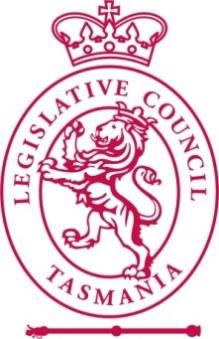
The Tasmanian Legislative Council is the upper house of the Parliament of Tasmania in Australia. It is one of the two chambers of the Parliament, the other being the House of Assembly. Both houses sit in Parliament House in the state capital, Hobart. Members of the Legislative Council are often referred to as MLCs.
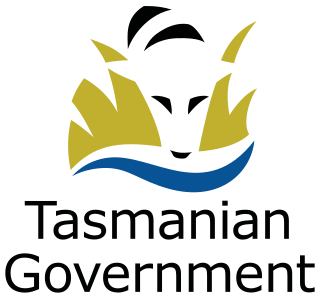
The Tasmanian Government or the Government of Tasmania is the executive branch of the Australian state of Tasmania. The leader of the party or coalition with the confidence of the House of Assembly, the lower house of the Parliament of Tasmania, is invited by the governor of Tasmania to form the executive. The governor appoints the premier of Tasmania.

Sir William John Lyne KCMG was an Australian politician who served as Premier of New South Wales from 1899 to 1901, and later as a federal cabinet minister under Edmund Barton and Alfred Deakin. He is best known as the subject of the so called "Hopetoun Blunder", unexpectedly being asked to serve as the first Prime Minister of Australia but proving unable to form a government.

Sir Henry Edward Fox Young, KCMG was the fifth Governor of South Australia, serving in that role from 2 August 1848 until 20 December 1854. He was then the first Governor of Tasmania, from 1855 until 1861.

Sir William Thomas Denison was Lieutenant Governor of Van Diemen's Land from 1847 to 1855, Governor of New South Wales from 1855 to 1861, and Governor of Madras from 1861 to 1866.

The Australian Constitutions Act 1850, or the Australian Colonies Government Act, was an Act of the Parliament of the United Kingdom which was enacted to formally establish the Colony of Victoria by separating the District of Port Phillip from the Colony of New South Wales. The Act provided an initial constitution for Victoria, which included a bicameral parliament and a Lieutenant-Governor as its vice-regal representative. It also altered the constitution of the Colony of New South Wales, and provided for similar constitutions to be set up in Van Diemen's Land (Tasmania) and South Australia.

The electoral division of Franklin is one of the five electorates in the Tasmanian House of Assembly, located in southern Tasmania and includes Bruny Island, Kingston and the eastern shore of the Derwent River. Franklin is named after Sir John Franklin, the Arctic explorer who was Lieutenant-Governor of Van Diemen's Land (1837–43). The division shares its name and boundaries with the federal division of Franklin.
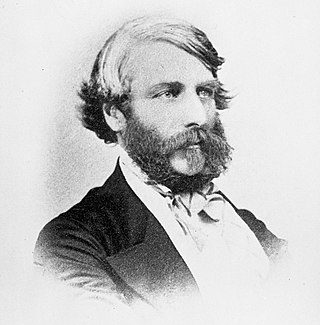
William Thomas Napier Champ was a soldier and politician who served as the first Premier of Tasmania from 1856 to 1857. He was born in the United Kingdom.
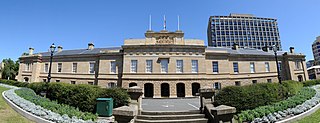
Parliament House, Hobart, located on Salamanca Place in Hobart, Tasmania, Australia, is the meeting place of the Parliament of Tasmania. The building was originally designed as a customs house but changed use in 1841 when Tasmania achieved self-government. The building served both purposes from 1841 to 1904, when the customs offices were relocated.

The states and territories are the second level of government of Australia. The states are administrative divisions that are self-governing polities that are partly sovereign, having ceded some sovereign rights to the federal government. They have their own constitutions, legislatures, executive governments, judiciaries and law enforcement agencies that administer and deliver public policies and programs. Territories can be autonomous and administer local policies and programs much like the states in practice, but are still legally subordinate to the federal government.

The Tasmanian Museum and Art Gallery (TMAG) is a museum located in Hobart, Tasmania. The museum was established in 1846, by the Royal Society of Tasmania, the oldest Royal Society outside England. The TMAG receives 400,000 visitors annually.

The Colony of Tasmania was a British colony that existed on the island of Tasmania from 1856 until 1901, when it federated together with the five other Australian colonies to form the Commonwealth of Australia. The possibility of the colony was established when the Parliament of the United Kingdom passed the Australian Constitutions Act in 1850, granting the right of legislative power to each of the six Australian colonies. The Legislative Council of Van Diemen's Land drafted a new constitution which they passed in 1854, and it was given royal assent by Queen Victoria in 1855. Later in that year the Privy Council approved the colony changing its name from "Van Diemen's Land" to "Tasmania", and in 1856, the newly elected bicameral parliament of Tasmania sat for the first time, establishing Tasmania as a self-governing colony of the British Empire. Tasmania was often referred to as one of the "most British" colonies of the Empire.

Edward Curr was an Australian settler and politician. Curr was born in Sheffield, England. He travelled to Hobart Town, arriving in February 1820. In 1823 he returned to England. In 1824 he was appointed manager of the newly formed Van Diemen's Land Company which had arranged to buy 250,000 acres of land in the north-west of the colony.

The Constitution of Tasmania, also known as the Tasmanian Constitution, sets out the rules, customs and laws that provide for the structure of the Government of the Australian State of Tasmania. Like all state constitutions it consists of both unwritten and written elements which include:
The 1856 Tasmanian colonial elections took place from 8 to 22 September 1856 and 6 to 17 October 1856. The elections were the first to be held under the Electoral Act 1856, which established responsible government in Tasmania and created a bicameral parliament consisting of the 30-member Tasmanian House of Assembly and the 15-member Tasmanian Legislative Council.
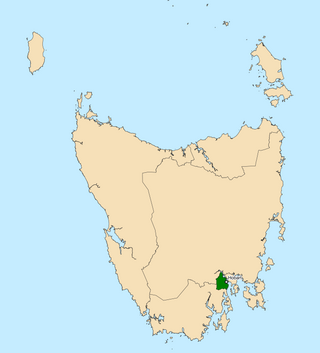
The electoral division of Clark is one of the five electorates in the Tasmanian House of Assembly, it is located in Hobart on the western shore of the River Derwent and includes the suburbs below Mount Wellington. Clark is named after Andrew Inglis Clark, a Tasmanian jurist who was the principal author of the Australian Constitution. The electorate shares its name and boundaries with the federal division of Clark.




















